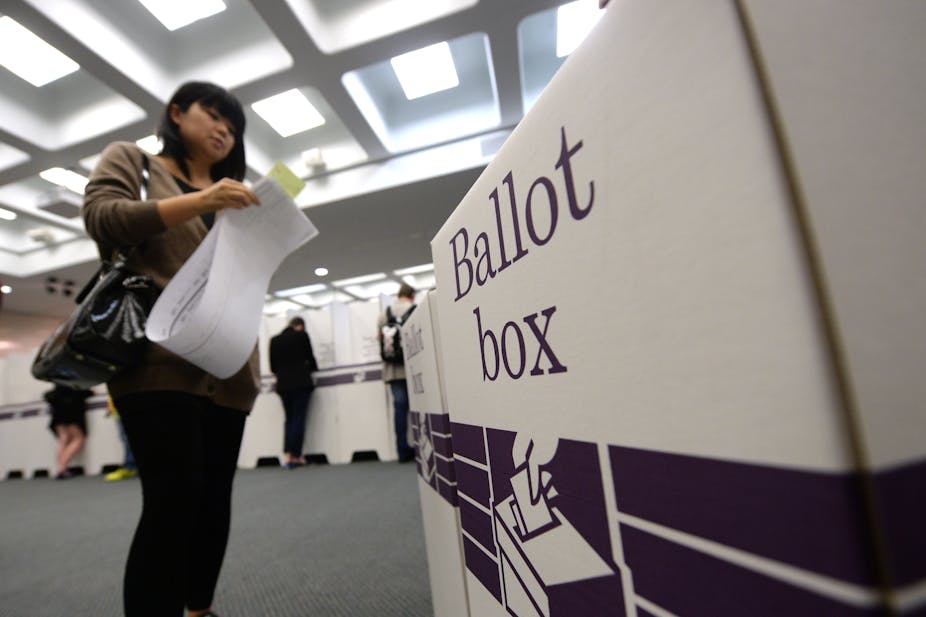Most Western Australian voters are justifiably annoyed at having to vote again as a result of the Australian Electoral Commission (AEC) losing 1370 Senate votes cast in the September 2013 federal election.
However, for political scientists, the new election provides us with what is likely to be a once-in-a-lifetime opportunity to chart changes in the behaviour of voters in two polls held within a tight timeframe.
As a result, the University of Western Australia is undertaking a survey of the electorate in the lead-up to the April 5 vote.
The unknown campaign
One of the interesting aspects of this election is that no-one is quite sure how the campaign will work. Fundamentally, this is a “second-order election”: government is not being formed.
In fact, the results of this election will not alter the make-up of the Senate to the extent that the government could form or lose a majority in the upper house. The most noticeable change is likely to be in the mix of minor parties, who hold the balance of power in the Senate.
Analysts are not the only ones struggling with the unusual aspects of this election. Usually, Australian federal election campaigns are leader-driven and dominated by senior members from the House of Representatives (the Greens and formerly the Democrats being the exception).
Traditionally, Senate candidates, particularly for the two major parties, aren’t selected for their charisma. And other than cabinet ministers and their shadows, the majority aren’t visible on the hustings during campaigns.
So far, the media and the major parties appear to be treating the election in the manner of a by-election. The first couple of weeks of the campaign have been very low-key. This is in part due to the Troy Buswell scandal, the South Australian and Tasmanian state elections and the disappearance of Flight MH370 dominating the news.
The campaign is expected to heat up in the final two weeks. All the key players have officially launched their campaigns.
Examining changes in voter behaviour
Following the announcement the Senate ballots had been lost, chatter around the watercooler led us to think that if Western Australians had to vote again, a number would consider voting differently. Some might be keen to vote below the line on the ballot paper, particularly after the machinations of minor party preference swaps were revealed at the September election.
This led us to wonder about intent versus action. Plenty of people intend to vote below the line, but when they get to the voting booth and see the large list of candidates, it all becomes a bit much. They fall back on the simpler alternative.
At the election in September, 3.83% of Western Australians voted below line, which was just slightly above the national average of 3.51%, but far lower than the 19.87% in the ACT.
Of course, far fewer candidates ran for the ACT’s two Senate seats. There were only 27 preferences to distribute below the line, as opposed to 62 in Western Australia. The number of candidates running in the April election is 77, which may further deter some people when it comes time to vote.
From an analytical point of view, the AEC will have produced two very comparable datasets for Senate voting in Western Australia once the votes from April 5 are counted.
While a recount was necessary due to the closeness of the first result and to ensure confidence in the robustness of our democracy, the 1370 votes equated to only 0.105% of the Western Australian 2013 Senate vote. This means we should have a very good idea about any changes in the behaviour of WA voters.
UWA has decided that a survey of the Western Australian electorate would be a useful additional tool in the analysis of this unexpected election.
Details of the survey
UWA wished to explore several factors, including:
- voters’ intention to change their vote and the manner in which they are voting;
- the issues that may have led them to consider changing their votes; and
- the level of political advertising they noticed during the campaign.
We are also interested in voters’ views of both the AEC and the possibility of moving to a system of electronic voting.
A number of the questions replicate those used in the Australian Election Study (AES), which is held after each federal election. The AES team has shared its 2013 results with us, which will allow for a certain level of benchmarking once we have our survey results.
The online survey can be completed in around five minutes. It is anonymous.
If you are eligible to vote in the Senate election on April 5, go here to fill out the survey. We would be grateful if you could direct other eligible voters to the survey. As an inducement, those who complete the survey have a chance to win a $500 voucher.

